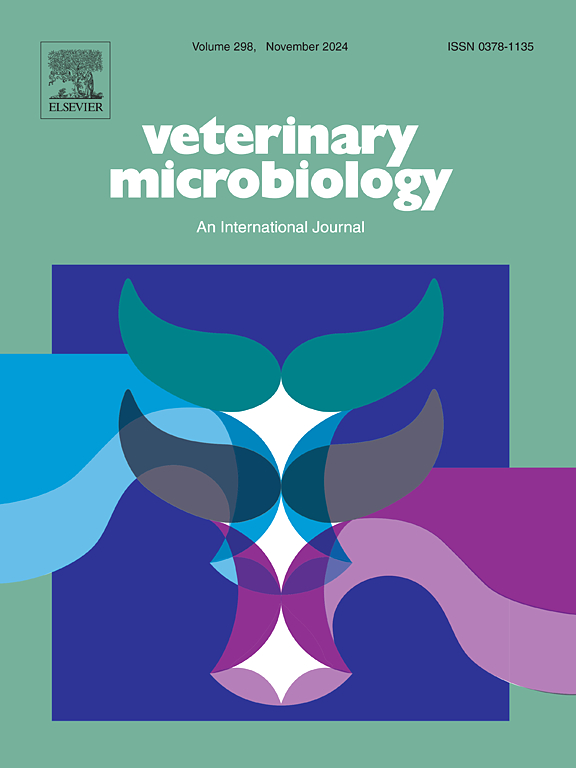BVDV通过ccdc50依赖性选择性自噬促进MDA5的降解,从而拮抗MDA5的抗病毒活性
IF 2.4
2区 农林科学
Q3 MICROBIOLOGY
引用次数: 0
摘要
牛病毒性腹泻-粘膜病(BVD-MD)是由牛病毒性腹泻病毒(BVDV)引起的一种影响养牛业的主要传染病。BVDV的非结构蛋白NS4B已被证明可诱导自噬并拮抗宿主先天免疫传感器MDA5的表达。然而,ns4b介导的MDA5抑制的确切机制尚不清楚。在这项研究中,我们证明NS4B与宿主蛋白CCDC50相互作用,通过共免疫沉淀和间接免疫荧光实验证实了这一点。在HEK293T细胞中,稳定过表达CCDC50可显著促进MDA5降解并增强BVDV复制,而敲低CCDC50可显著损害ns4b介导的MDA5降解。有趣的是,CCDC50还抑制了BVDV感染期间I型干扰素(IFN-I)和干扰素刺激基因(ISGs)的产生。此外,CCDC50的易位通过自噬途径降低了MDA5蛋白水平。在机制上,我们发现CCDC50与MDA5相互作用,促进ns4b介导的MDA5自噬降解。这些发现揭示了BVDV NS4B通过促进MDA5自噬降解和抑制IFN-I信号传导来劫持宿主蛋白CCDC50破坏抗病毒先天免疫的新机制。本文章由计算机程序翻译,如有差异,请以英文原文为准。
BVDV antagonizes the antiviral activity of MDA5 by promoting its degradation via CCDC50-dependent selective autophagy
Bovine viral diarrhea-mucosal disease (BVD-MD), caused by bovine viral diarrhea virus (BVDV), is a major infectious disease affecting the cattle industry. The nonstructural protein NS4B of BVDV has been shown to induce autophagy and antagonize the expression of the host innate immune sensor MDA5. However, the precise mechanism underlying NS4B-mediated suppression of MDA5 remains unclear. In this study, we demonstrate that NS4B interacts with the host protein CCDC50, as confirmed by co-immunoprecipitation and indirect immunofluorescence assays. Stable overexpression of CCDC50 significantly promoted MDA5 degradation and enhanced BVDV replication, whereas CCDC50 knockdown markedly impaired NS4B-mediated degradation of MDA5 in HEK293T cells. Interestingly, CCDC50 also suppressed the production of type I interferons (IFN-I) and interferon-stimulated genes (ISGs) during BVDV infection. Furthermore, the translocation of CCDC50 reduced MDA5 protein levels through the autophagy pathway. Mechanistically, we found that CCDC50 interacts with MDA5 and facilitates NS4B-mediated autophagic degradation of MDA5. These findings uncover a novel mechanism by which BVDV NS4B hijacks the host protein CCDC50 to subvert antiviral innate immunity by promoting MDA5 autophagic degradation and suppressing IFN-I signaling.
求助全文
通过发布文献求助,成功后即可免费获取论文全文。
去求助
来源期刊

Veterinary microbiology
农林科学-兽医学
CiteScore
5.90
自引率
6.10%
发文量
221
审稿时长
52 days
期刊介绍:
Veterinary Microbiology is concerned with microbial (bacterial, fungal, viral) diseases of domesticated vertebrate animals (livestock, companion animals, fur-bearing animals, game, poultry, fish) that supply food, other useful products or companionship. In addition, Microbial diseases of wild animals living in captivity, or as members of the feral fauna will also be considered if the infections are of interest because of their interrelation with humans (zoonoses) and/or domestic animals. Studies of antimicrobial resistance are also included, provided that the results represent a substantial advance in knowledge. Authors are strongly encouraged to read - prior to submission - the Editorials (''Scope or cope'' and ''Scope or cope II'') published previously in the journal. The Editors reserve the right to suggest submission to another journal for those papers which they feel would be more appropriate for consideration by that journal.
Original research papers of high quality and novelty on aspects of control, host response, molecular biology, pathogenesis, prevention, and treatment of microbial diseases of animals are published. Papers dealing primarily with immunology, epidemiology, molecular biology and antiviral or microbial agents will only be considered if they demonstrate a clear impact on a disease. Papers focusing solely on diagnostic techniques (such as another PCR protocol or ELISA) will not be published - focus should be on a microorganism and not on a particular technique. Papers only reporting microbial sequences, transcriptomics data, or proteomics data will not be considered unless the results represent a substantial advance in knowledge.
Drug trial papers will be considered if they have general application or significance. Papers on the identification of microorganisms will also be considered, but detailed taxonomic studies do not fall within the scope of the journal. Case reports will not be published, unless they have general application or contain novel aspects. Papers of geographically limited interest, which repeat what had been established elsewhere will not be considered. The readership of the journal is global.
 求助内容:
求助内容: 应助结果提醒方式:
应助结果提醒方式:


